“With the first link, the chain is forged. The first speech censured, the first thought forbidden, the first freedom denied, chains us all irrevocably.” -Aaron Satie, Star Trek
It’s been a remarkable week at Starts With A Bang, and I'm especially proud of the stories we've run on Proxima b, Hubble's limits, the dream of Warp Drive and the Cosmic Neutrino background. If you missed any of them (or any of the others), here's what the past week has held:
- When will the Sun make Earth uninhabitable? (for Ask Ethan),
- What is the biggest black hole as seen from Earth? (for Mostly Mute Monday),
- Ten ways Proxima b is different from Earth,
- Why Hubble will never see the first stars,
- Star Trek's warp drive might become a reality, and
- Cosmic neutrinos detected, confirming the Big Bang's last great prediction.
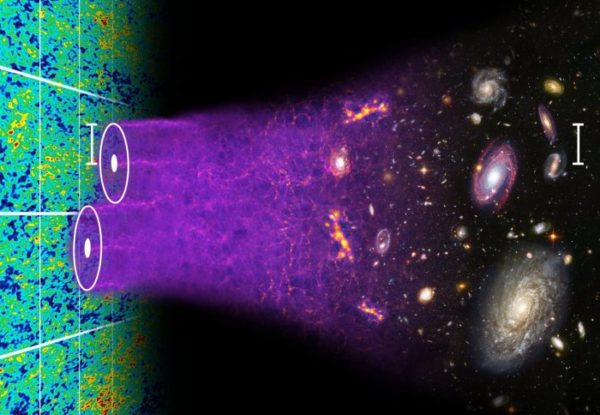 An illustration of the concept of Baryonic Acoustic Oscillations, which detail how large scale structure forms from the time of the CMB onward. This is also impacted by relic neutrinos. Image credit: Chris Blake & Sam Moorfield.
An illustration of the concept of Baryonic Acoustic Oscillations, which detail how large scale structure forms from the time of the CMB onward. This is also impacted by relic neutrinos. Image credit: Chris Blake & Sam Moorfield.
Some new things are also on the horizon:
- Thanks to a special gift from one of my Patreon supporters, there's now a High School classroom in a public Florida school that's being outfitted with a supply of my book, Beyond The Galaxy, for their astronomy classes, along with lesson plan/lab suggestions, consultations and a live video chat session with me!
- The topic for this month's Starts With A Bang podcast will be about Proxima b; if you have a specific suggestion for what you want covered, let us know now!
- And the ban on See Noevo seems to have elevated the quality of the comments here, so it will continue for another week as part of the trial. For those of you who miss him, I found this, so maybe that will make up for his absence?
With all of that said, it's time to dive into our comments of the week!
From axil on non-frozen worlds: "One oddity that Ethan has not yet covered is why Ceres and Pluto have liquid oceans beneath a frozen crust causing recent, ongoing and active cryovolcanism and regenerating atmospheres."
About eight years ago, back when I first started writing on the internet, I was looking for an answer to the question: "why is the core of the Earth so hot?" Back then, Wikipedia was in its infancy and the internet was a much less reliable place than it is even today, and so I was actually stoked to find this very question on Yahoo answers, because I didn't know whether gravitational contraction or radioactive decays would be the dominant source of heat in Earth's core. Thankfully, Yahoo answers was there for me, as the number one upvoted answer came onto my screen, informing me "because i keep farting." All lowercase, but with a period. Thank you, internet.
 The 2001-2002 composite images of the Blue Marble, constructed with NASA's Moderate Resolution Imaging Spectroradiometer (MODIS) data.
The 2001-2002 composite images of the Blue Marble, constructed with NASA's Moderate Resolution Imaging Spectroradiometer (MODIS) data.
It turns out that on Earth, the heat of our planet's interior comes in about a 50/50 ratio from those two sources: gravitational contraction and radioactive decay of elements. All spherical, differentiated worlds should have large stores of materials that are still rich in radioactive elements on decay timescales of billions of years. You will have to wait a long time for them to be completely frozen; this is not a mystery to science.
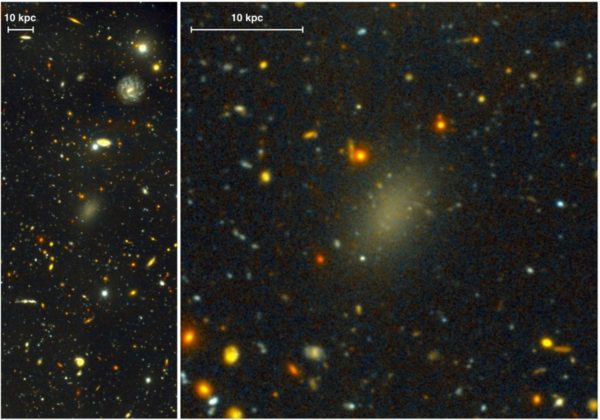 An image of galaxy Dragonfly 44, recently discovered to have the largest offset between normal matter and dark matter of any known, large galaxy. Image credit: Pieter van Dokkum, Roberto Abraham, Gemini Observatory/AURA.
An image of galaxy Dragonfly 44, recently discovered to have the largest offset between normal matter and dark matter of any known, large galaxy. Image credit: Pieter van Dokkum, Roberto Abraham, Gemini Observatory/AURA.
From Alan L. on Dragonfly 44: "How fast is the 99.99% Dark Matter Dragonfly 44 galaxy travelling through the interstellar medium as compared to the 26,000 kps of ESO 137-001 (the other galaxy pictured, I believe)."
You must recognize, first off, that the 10,000-to-1 ratio is likely to be an exaggeration of a ratio that's much more likely to be 100-to-1. The 100-to-1 figure is based on observations while the larger ratio is with the addition of conventional dark matter simulations that have been shown to pose many difficulties and tensions with observations on smaller scales. But your question is still valid, and Dragonfly 44 isn't moving all that fast, relatively speaking. The Coma Cluster has a recession velocity from us of around 6925 km/s, while Dragonfly 44 has a redshift corresponding to a speed of 6280 ± 120 km/s. So it's "only" moving around in the cluster at around 700 km/s, which is fairly typical of a galaxy's velocity within a cluster like that.
But the bigger question is what was its velocity when it first fell in, and how significantly has stripping and friction reduced it? That's information we don't have.
The anatomy of the Sun, including the inner core, which is the only place where fusion occurs. Image credit: NASA/Jenny Mottar.
From Omega Centauri on Earth's eventual demise due to the Sun's heating: "There is likely a lot of uncertainty in the planets response to rising illumination. As long as the planetary thermostat is operating, and CO2 is kept low enough to keep surface temperature in check things can muddle on. One issue is how low a CO2 concentration can we have and still have plants."
Lowering the greenhouse effect that significantly is going to be very difficult, particularly owing to the difficulty of removing water vapor and clouds from the atmosphere even if you could turn the CO2 and CH4 thermostats way down. The H2O "blankets" we're pretty much stuck with, and that's a problem.
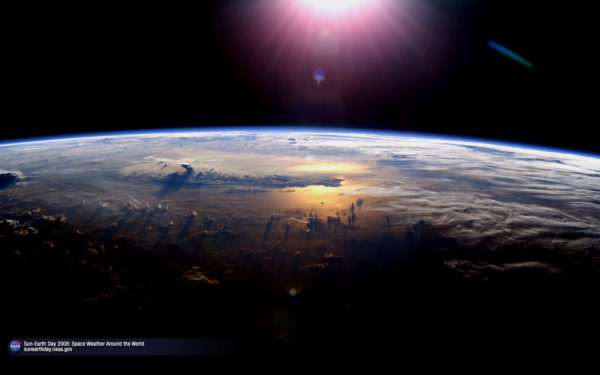 The Setting of the Sun Over the Pacific Ocean and a Towering Thundercloud, July 21, 2003. As Seen From the International Space Station (Expedition 7). Image credit: NASA / Johnson Space Center.
The Setting of the Sun Over the Pacific Ocean and a Towering Thundercloud, July 21, 2003. As Seen From the International Space Station (Expedition 7). Image credit: NASA / Johnson Space Center.
From Andrew Dodds on a geoengineering solution to a brightening Sun: "Simply putting a solar shield at a suitable lagrange point (L1, I think) would be fine, and we could just about to it with current technology, never mind the whole redirecting-asteroids thing."
There are lots of technologies, and a large solar shield at L1 is a great solution. It's even conceivable to make a large porous shield that say, filters out the appropriate percentage of light. Recall that L1 is an unstable point, so we'll have to constantly tweak and/or replace the shield, but this isn't unfathomable even with current technology, as Andrew points out. There are other solutions as well that involve modifications to the Earth, the sunlight en route, or to our planet's orbit. If we (or our eventual evolutionary descendants) live long enough, I don't doubt we'll figure this out.
From Rick on the Earth's warming: "So like every 32 million years, Earth sees 1 degree Fahrenheit change … that’s what spreadsheet says when I back calculate Earth temperature 4 billion years ago at 80% sun illumination?"
Woah that's WAY too fast! We currently receive ~1370 W/km^2 at the top of the atmosphere from the Sun; 32 million years ago we received roughly ~1368 W/km^2 at the top of the atmosphere, assuming that 4 billion years ago we were at 80% the amount of the Sun's power we're at today: a 0.16% increase in power. Now a certain percentage is absorbed while some is reflected (albedo), a certain amount is re-absorbed after being re-radiated by the Earth (the greenhouse effect), etc., but a 0.16% increase in power doesn't mean a 0.16% increase in temperature. The temperature of a radiating body scales as the power to the (1/4) power, meaning that the Earth was only 0.04% cooler, which corresponds to every 32 million years, Earth seeing a 0.25º F temperature change, not 1º F. The Earth is warming, but not that fast!
The expected view of the Milky Way's supermassive black hole through the Event Horizon Telescope. It should be the only one directly visible. Image credit: S. Doeleman et al., via http://www.eventhorizontelescope.org/docs/Doeleman_event_horizon_CGT_CF….
From Michael Kelsey on black hole diameter: "You’re right that Ethan states, in his conclusions, that Sgr A* has an angular size of 19 uas. But that’s wrong, I think: Doeleman (2008) published a size of 37 uas, which is still the best value (EHT isn’t online yet). I suspect the difference is as simple as radius vs. diameter."
I suspect this is right, too. What's also worth pointing out is, do you remember how the starlight bending of the background stars near a Sun's limb due to General Relativity is larger than the Newtonian prediction? Well, the bending of the background light from a black hole's gravity is larger, too, meaning that there's a difference in the physical angular size of an event horizon and the apparent angular size of an event horizon as seen by an observer. This may also account for/contribute to the differences between the two figures.
The Earth (L) in visible light, compared with Venus (R) in infrared light. While Earth’s reflectivity will vary over time, Venus’ will remain constant. Image credit: NASA/MODIS (L), ISIS/JAXA (R), stitching by E. Siegel.
From Craig Thomas on Venus vs. Mars: "Venus is scorching hot.
Mars is cold and most of its CO2 has been blown off it."
Venus also appears to be continuously generating new atmosphere, while Mars does not. Also, Mars' remaining atmosphere is mostly CO2. In fact, it's so much mostly CO2 that you might enjoy seeing how bad it is:
The 95%+ atmosphere of carbon dioxide is something that Mars and Venus have in common. Venus apparently had a CO2 "explosion" due to geological effects; if Mars never did, it's conceivable that most of its original CO2 remains. It's even possible that it's organic in nature, although it may be inorganic as well.
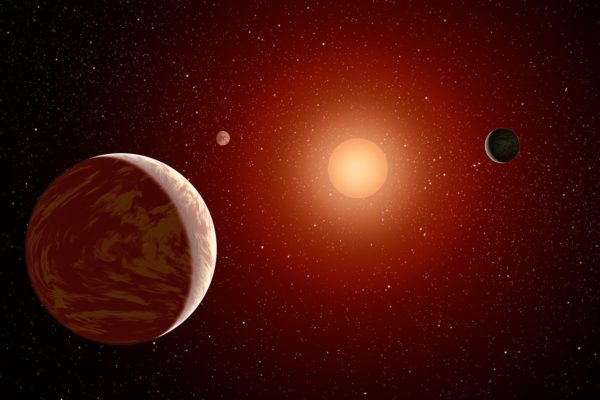 All inner planets in a red dwarf system will be tidally locked, with one side always facing the star and one always facing away, with a “ring” of Earth-like habitability between the night and day sides. Image credit: NASA/JPL-Caltech.
All inner planets in a red dwarf system will be tidally locked, with one side always facing the star and one always facing away, with a “ring” of Earth-like habitability between the night and day sides. Image credit: NASA/JPL-Caltech.
From Sean T on Proxima b vs. Earth in terms of magnetic field: "If Proxima b’s year is 11 days long, would not its rotational period also be 11 days if it’s tidally locked? In your #4 you point out that the lack of rotation would make a magnetic field improbable, but the planet does in fact rotate, just more slowly than earth. That would make the magnetic field weaker, but would it not still be possible for Proxima b to have a field?"
It sure would be possible! But yes, the magnetic field, all other things being the same, would be 1/11th the strength of the magnetic field on Earth. But I'll just throw this little factoid out there: at 1/11th its strength, the inner and outer Van Allen belts would both be located inside the interior of the Earth, with the outer Van Allen belt extending almost to the top of Earth's mantle.
Something else would have to compensate to make Proxima b's field stronger.
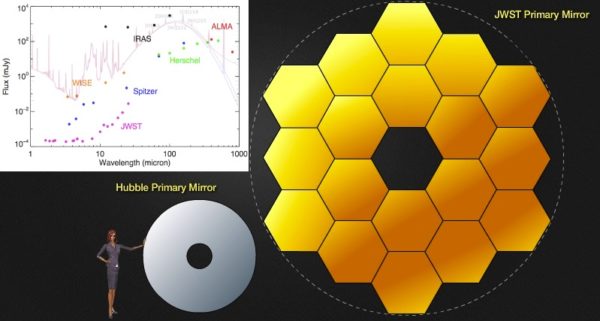 The James Webb Space Telescope vs. Hubble in size (main) and vs. an array of other telescopes (inset) in terms of wavelength and sensitivity. Image credit: NASA / JWST team.
The James Webb Space Telescope vs. Hubble in size (main) and vs. an array of other telescopes (inset) in terms of wavelength and sensitivity. Image credit: NASA / JWST team.
From Narad on Hubble vs. JWST: "It’s been noted before, but the figure in that image is just weird."
I don't understand what you mean by "that image is weird," because it looks perfectly normal to me. Correctly scaled and shaped mirrors, appropriately scaled human, etc. So I followed your link and pulled out,
"Hmmm, the woman in the diagram is pretty tall, 1.8 meters — 6 feet! Of course, she’s in heels. But should she really have her hand on that priceless (if incorrectly ground) mirror?"
So I guess I agree with the "weird" part, in that something is weird. But it isn't the image, and it isn't the mirrors. (How dare a woman be on the tall side of normal for a woman?) I think I'll continue to use it without reservation.
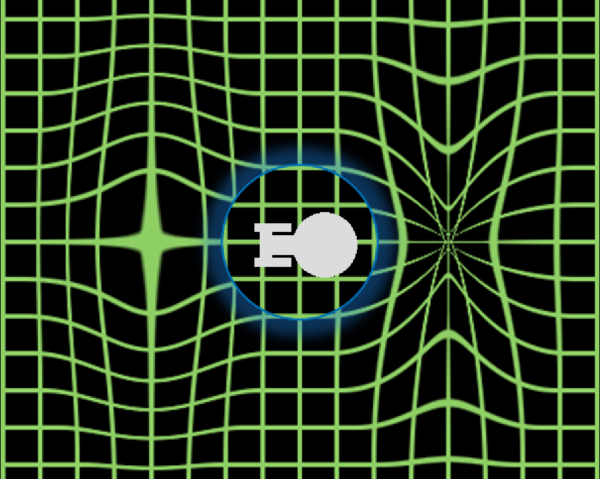 A warp field from Star Trek, which shortens the space in front of it while lengthening the space behind it. Image credit: Trekky0623 of English Wikipedia.
A warp field from Star Trek, which shortens the space in front of it while lengthening the space behind it. Image credit: Trekky0623 of English Wikipedia.
From eric on warp drive and our traditional notions of causality: "So, why hasn’t one of humanity’s future Alcubierre-drive ships visited us here and now to jumpstart the process and give us the science and engineering info needed to build it? You’re telling me there is not one future descendent of a Holocaust survivor at any time in humanity’s future after this drive is invented, that gains the means and motivation to go back and kill Hitler?"
You still can't do those things with warp drive, mind you. Our traditional notions of causality are that two distant observers (or whatever you want to have at a distance) can only transmit signals, information or exchange anything at the speed of light, no faster. So if you have something travel at, say, 100 times the speed of light, suddenly you could witness a supernova at a star 100 light years away, travel to Earth, and say, "in exactly 99 years, you'll need to build a neutrino detector, this new type of telescope and look here at this moment to witness it." And this is something you couldn't do with our conventional notions of causality. But you can't go back in time and "stop" the supernova by removing mass from the star; you can still only go forward.
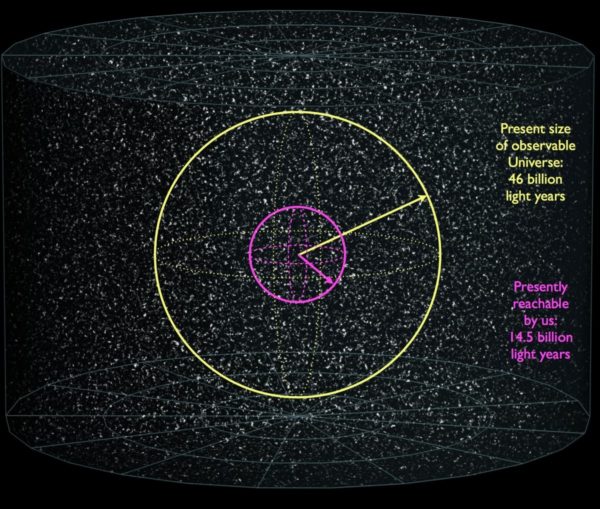 The size of our visible Universe (yellow), along with the amount we can reach (magenta). Image credit: E. Siegel, based on work by Wikimedia Commons users Azcolvin 429 and Frédéric MICHEL.
The size of our visible Universe (yellow), along with the amount we can reach (magenta). Image credit: E. Siegel, based on work by Wikimedia Commons users Azcolvin 429 and Frédéric MICHEL.
From doug on our reach with warp drive: "Wow does that mean we could also explore the currently ‘unobservable’ part of the universe?"
Not only is the answer to that "yes," but depending on how much faster than light we could go, we could potentially reach tens, hundreds or even millions of times the part of the Universe we presently perceive the "observable limit" to be. And if we could get there, outracing the photons, we'd be able to see what our Milky Way was like in the past as we moved farther and farther away.
In a sense, warp drive itself would be the ultimate forensic investigatory tool!
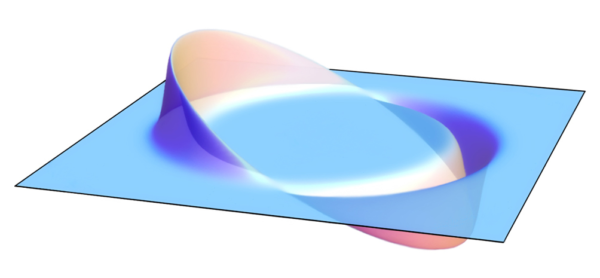 A two-dimensional projection of the Alcubierre spacetime, where space itself is shortened in front of the spacecraft and lengthened behind it. Image credit: Wikimedia Commons users AllenMcC., under a c.c.a.-s.a.-3.0 license.
A two-dimensional projection of the Alcubierre spacetime, where space itself is shortened in front of the spacecraft and lengthened behind it. Image credit: Wikimedia Commons users AllenMcC., under a c.c.a.-s.a.-3.0 license.
From Mandozink on how FTL travel is possible: "I need an explanation of how particles would be able to move faster than the fields that they exist in."
The concept of the Alcubierre drive is all about altering the gravitational metric of space, which you can interpret as a gravitational field. Nothing is moving faster than light or faster than the fields they exist in; rather, the existence of negative mass allows the compression of space in one direction (ahead) coupled with a rarefaction in the other direction, meaning that the matter inside the bubble is motionless, and it's only that the space itself around the bubble is changing in its properties.
Also, sorry to hear about the cancer. From what I know, life has thrown a number of difficulties -- many unfair ones -- at you. I wish you well, for all the good that can do.
The fit of the number of neutrino species required to match the CMB fluctuation data. Image credit: Brent Follin, Lloyd Knox, Marius Millea, and Zhen PanPhys. Rev. Lett. 115, 091301 — Published 26 August 2015.
And finally, from Sean T on the cosmic neutrino background: "Near the end of the article you wrote something to the effect that the observed phase shifts allow us to calculate what the temperature of the CNB would be if neutrinos were massless. Neutrinos, we know now, have a small mass. How does this affect the calculation of the CNB temperature (if at all)?"
So for a little more specifics, what we're detecting isn't the 1.95 K neutrino background today, but rather the effect that the additional species of radiation with three neutrinos has on the CMB fluctuations at the time of the CMB's release, at z ~ 1089. The smallness of a neutrino's mass means that neutrinos were ultrarelativistic back then; if a neutrino had a mass of 0.1 eV (still too massive for what's allowed given current constraints), its mean speed at that redshift would be about 94% the speed of light. With more realistic mass estimates, it's closer to 96-98% the speed of light.
We cannot detect the deviations from c with current sensitivity, but what the massiveness of neutrinos means is that it would have a temperature of 1.95 K if it were massless, and that instead it has that same kinetic energy, plus whatever speed it's gained from falling into the gravitational potential wells (of galaxies, clusters, etc.) of the objects they're now gravitationally bound to.
Thanks for a great, science-oriented week of comments, everyone, and looking forward to the next one, too!



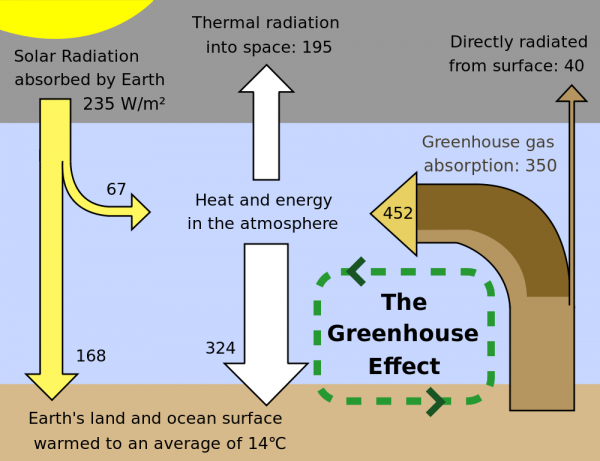

@Ethan
Just for mention, I corrected the velocity of ESO in a later post from 26,000 to 2000 kps following a post from narod.
A geoneutrino is an electron antineutrino emitted in β− decay of a radionuclide naturally occurring in the Earth. Neutrinos, the lightest of the known subatomic particles, lack measurable electromagnetic properties and interact only via the weak nuclear force.
Muon neutrinos are produced by LENR. When the type of geoneutrinos are characterized by the new large neutrino detectors coming from the nuclear reactions produced inside the earth, they will be discovered to be muon neutrinos.
Ethan, both you and Sean seem to accept a scaling of planetary magfield strength with rotation rate. Is such a simple scaling law justified. As far as I know, the magnetic field is a result of complicated MHD effects operating on fluid flows within a Planets iron-Nickel core. Those flows can be driven by both thermal gradients (traditional convection), and differential rotation of the core/mantel. On earth the later effect is caused because the mechanical coupling of the core and mantel is weak enough that the core cannot keep up with the precession of the rest of the planet. The fluid motion in a conductive fluid allows amplification of pre-existing mag fields, which once they become strong enough can effect the flow as well, so its a rather complicated MHD problem. Do we really have a good handle on how we would expect field strength to scale with rotation and core size?
@eric #3: No. The "absolute time frame" is an artefact of trying to use simple, plain English to communicate.
The quantitative effect of true causality violation in special relativity, as a result of travel faster than light, is well known and is usually a homework problem in the first or second week of a typical SR physics class.
Draw a Minkowski diagram of two spatially and temporally separated events (with B after A) and work out what happens if you apply a transformation with v > c. The result is left as an exercise to the reader.
The short version for you eric is that you define the frame of reference since you're the one going there and back.
Issues arising are if you go via warp drive then some years later go again with a FASTER warp drive and get there before you got there the first time then intefered with yourself from the earlier time later.
This, though, CAN be physically possible, since there's still a single causality chain, you just happen to exist with your personal frame of reference there for multiple occasions.
Why should reality have to make sense all the time? It's only fantasy that has to be limited to what you can imagine. Reality can select from a much wider gamut.